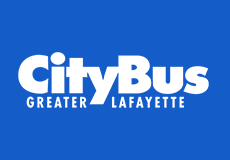
About CityBus
- Located in Lafayette, Indiana
- Operates a fixed route transit service
The Problem / Challenge
- Radio communication was inefficient and prone to inaccuracy
Solution
- TripSpark Streets Fixed Route Software
Results
- Drivers don’t have to rely on dispatch
- Drivers know what transfers they need, even when they’re running late
About CityBus
Located in Lafayette, Indiana, CityBus operates a fixed route transit service to ferry city commuters to and from work, as well as busy students from Purdue University West Lafayette campus and Ivy Tech. Melissa Baldwin is the CAD/AVL Supervisor at CityBus and was part of the team, instrumental in developing a solution for their scheduling and transfer process problems. CityBus operates a “spoke style” service in that a central hub connects riders to their destination. Their newly constructed transfer hub allows 10 buses to meet every half hour in the downtown core. Built to create efficiency and comfort, riders enjoy the climate-controlled waiting and rest areas. From the hub, riders transfer to any number of urban and rural destinations. Obviously, transfer priority is essential for CityBus to deliver exceptional service to their ridership, which is also a priority.
The Problem / Challenge
Their ridership is routinely on very tight schedules, whether they are students on their way to campus, or commuters on their way to work. Due to the amount of routes and connections they manage, CityBus has an incredibly diverse and therefore complicated system. Riders were finding the transfer process confusing due to CityBus’s interline system, whereby bus numbers change to align with new routes. This confusion, added to the increasing city maintenance was making Melissa’s job a great deal harder as she was (and continues to be) on the front lines when driver and rider complaints come in.
“Radio communication was inefficient and prone to inaccuracy. ”
On an average day, they enter around 350 transfer requests for more than 485 riders. Up until a fixed route software solution with transfer protection was implemented, CityBus dispatchers and drivers were recording transfer requests manually, on pieces of paper. Drivers were relied upon to memorize requests one at a time, as they were being made by riders. This caused confusion for drivers. Not knowing if connecting riders were about to arrive at the hub meant that a driver didn’t know how large a wait time window to leave. Leaving too early meant that riders would miss their transfer. Leaving too late would
destabilize the on-time performance of the route. Radio communication was the only means by which drivers could get vital transfer information from dispatch, but this system rarely ran smoothly.
Fixed Route Software Solution
In 2009, Melissa led the team that implemented TripSpark Streets Fixed Route Software. This enabled CityBus to schedule and dispatch vehicles with more efficiency and develop an overview of operation to determine optimal routes and bus stop locations. As well, they added the Transfer Protection module to accompany the building of their new transfer hub. The software is designed to fully integrate into the existing Streets solution and after careful testing, Melissa describes some of the immediate benefits of having an automated system for data entry, tracking and driver communication.
“Drivers don’t have to rely on dispatch, which may be busy with several tasks. ”
Requests are now made through their in-vehicle MDT (Ranger Console) and its touchscreen display. Messages are also sent via a cellular UDP interface, connecting buses and their drivers. Once a request is made and an appropriate holding bus is designated, either the system automatically approves the request or a dispatcher can intervene, canceling it. If the schedule is running behind, dispatchers can always override the request to keep the schedule intact. Because Streets can monitor the location of buses on their routes using AVL, it can calculate accurate arrival times. Real-time data is pushed to the in-vehicle consoles of connecting bus drivers so they can make last-second decisions on whether to add 2-3 minutes to their wait times or not.
“Drivers know what transfers they need, even when they’re running late. ”
Radio traffic has been greatly reduced and information is far more accurate than the days when scraps of paper were the only method for tracking and remembering transfer requests. Drivers now have a greater depth of information. They can make better decisions about when it is okay to leave a stop and more importantly, how long they can wait. Riders now also have more assurance that they’ll make their connections on time because their transfer requests have been sent digitally.
“Dispatchers play with thresholds if they can. ”
Future plans for CityBus include an awareness campaign to educate riders on how to use their system more effectively. Access to TripSpark MyRide and MyBus, allow riders to plan their trips by knowing the next three buses that will be departing from their chosen stop. Riders need to be aware that wait time windows are only 3 minutes, so they should be prepared, and having access to accurate passenger information is the first step in being prepared.
“The capabilities of [TripSpark] Streets is strong but the front end software is easy to use. It’s been very beneficial to us to have software our staff can actually use. ”
John Metzinger, Manager Development
CityBus has found operational benefits to both Streets ITS and the addition of Transfer Protection. For better insight and depth of information, automation is the key piece of the puzzle.
